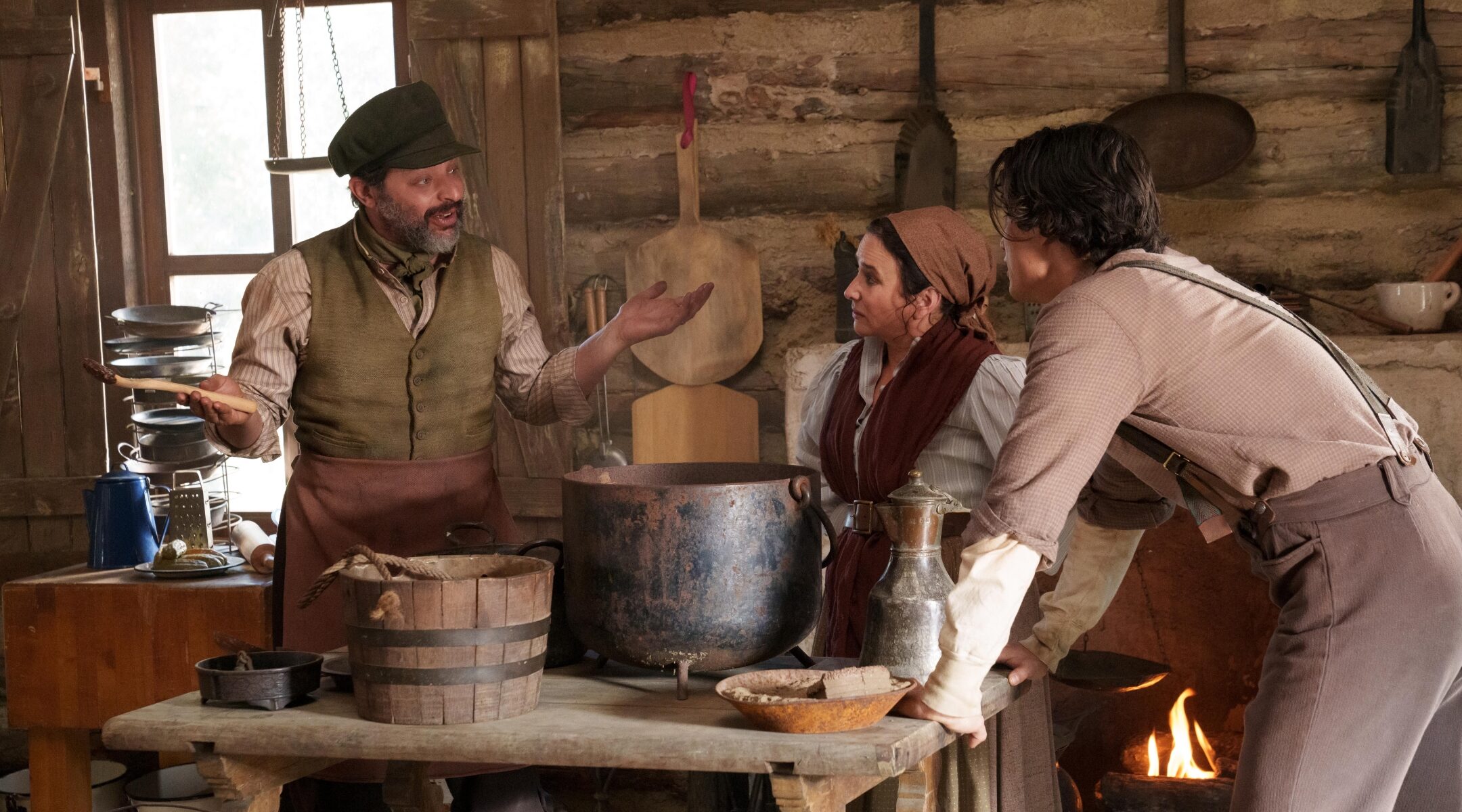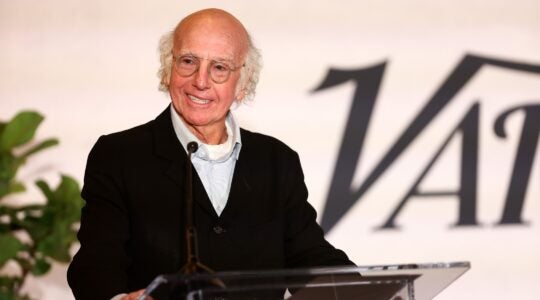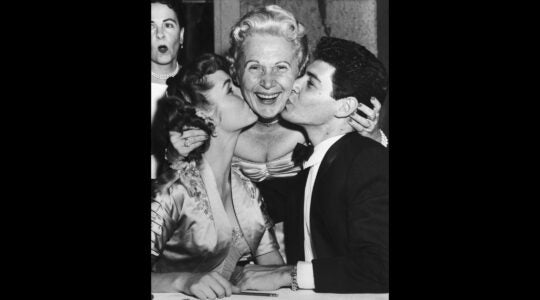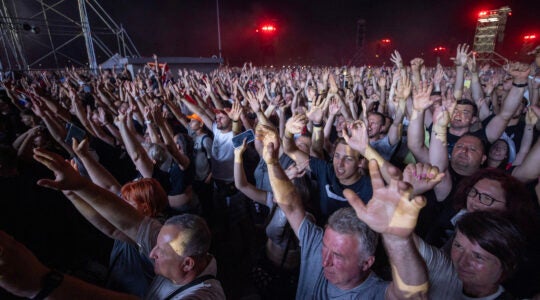Spoilers for “History of the World: Part II” follow.
(JTA) – Finally fulfilling the promise Mel Brooks made in 1981, the long-belated “History Of The World, Part II” brings us … “Hitler on Ice.”
For a sketch first teased during the end credits of Brooks’ film “History Of The World, Part I,” the leader of Nazi Germany can be seen attempting to land some difficult moves (perhaps a triple Axis?) at an Olympics-like skating competition.
Needless to stay, Hitler wasn’t known as a figure skater. But some aspects of the sketch — such as why collaborationist Vichy France would give the Nazi leader’s routine a perfect score — might benefit from a more detailed understanding of the real history that’s being pilloried.
The same goes for the sendups of Christianity, the Russian Revolution and Henry Kissinger — all historical events and figures depicted in the series, the first episodes of which landed on Hulu on Monday. Produced by Brooks and offering up its share of his Catskills-style Jewish humor, the eight-episode, four-night romp through history stops frequently on items of Jewish interest. Some sketches recur throughout the series.
So here is your guide to the real-life Jewish history of “History of the World, Part II,” to be updated daily as new episodes drop.
The Russian Revolution
In a longer narrative first introduced in Episode 1, the show’s depiction of the fall of the Russian Empire is a high-wire blend of parodies and stylistic influences, as well as a crash course on Russian antisemitism.
It begins with a grody depiction of early-1900s Jewish shtetl life borrowing heavily from “Fiddler on the Roof.” Mud-pie dealer and patriarch Shmuck Mudman, played by Jewish actor Nick Kroll, uses a truncated song-and-dance number (“Submission”) to encourage his feisty son to follow Jewish traditions and stay away from cosmopolitan life in Moscow. But his son is unconvinced: “The shtetl stinks, it’s no place for a Jew.” Like Anatevka, the tiny Jewish village from “Fiddler,” the Jews are heavily implied to be living in the “Pale of Settlement,” the only region of the Russian Empire where Jews were permitted to live starting in the early 19th century and lasting until the Russian Revolution in 1917. State-backed schooling and “Russianization” programs sought to erode Jewish communal identity and replace it with a Russian national identity; a small number of Jews were allowed to work or study beyond the Pale if they had special skills.
In “History,” the Mudmans, including a mother played by Jewish comic Pamela Adlon, are menaced by the Cossacks, the Ukrainian mercenaries and feared horsemen who carried out a series of pogroms agains the Jews often at the behest of the Russian state. Meanwhile, the gilded Romanov family are depicted as Kardashian-like beauty influencers headed up by Tsar Nicholas II (Danny DeVito), who discovers their empire is on the brink of collapse.
In real life, the Russian Revolution liberated the state’s Jewish population with the fall of the tsar in 1917, and a large percentage of Communist party members at the time were Jewish. (Like DeVito, Nicholas II in real life was a short man, around five-foot-six.) In the decades to follow, Communist rule would come to have a devastating effect on the Jews of the Soviet Union, suppressing their religion and culture, and purging many of the Jewish party members.
Hitler on ice
It’s hard to impress a team of international judges when you’re the genocidal maniac who tried to conquer them.
In the skit, Hitler is despondent when judges from the countries in which he waged war all give him zeroes — with the exception of Vichy France, which awards him a perfect score, and Poland, which awards him an expletive. (It’s an uneasy restaging of the line “Winter for Poland and France,” from “Springtime for Hitler,” the musical highlight in Brooks’ “The Producers.”)
The scores reflect Nazi Germany’s relationship with the countries: It conquered France and installed a puppet government that acquiesced to Hitler’s orders to round up and denationalize the country’s Jews. Meanwhile, the Nazis invaded Poland in 1939, dividing up its rule with the Soviets and murdering much of its Jewish population in the Holocaust. Unlike the French government, which signed an armistice with Germany after heavy losses to clear the path for Vichy rule while preserving the Republic in name, Poland does not acquiesce to a collaborationist narrative; decades later, it is illegal in Poland to suggest that the country was complicit in Nazi atrocities.
But these wartime victories make Hitler the loser of “Hitler on Ice.” Accompanied by his “coach” Joseph Goebbels (the Nazis’ propaganda minister) and partner Eva Braun, this Hitler hangs his head in shame as he trudges away to the jeers of the crowd, intending to go shoot himself in his Berlin bunker in a repeat of his actual death by suicide at the end of World War II.
“If you put concentration camps in people’s countries,” offers one of the sportscasters (played by Jewish comic Ike Barinholtz), “you better be flawless on the ice.”
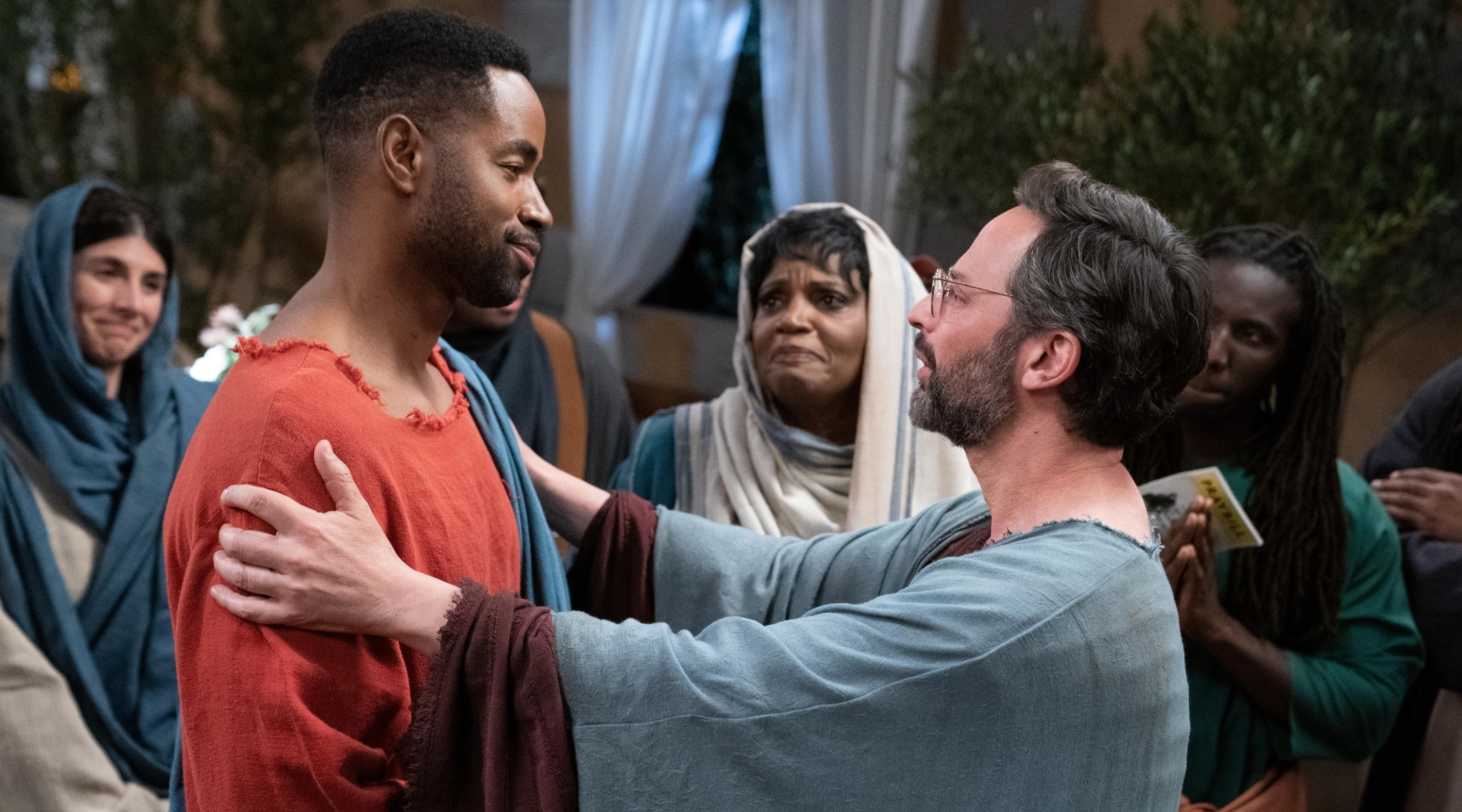
Jesus (Jay Ellis) and Judas (Nick Kroll) in a scene from the “Curb Your Judaism” sketch in “History of the World, Part II.” (Aaron Epstein/Hulu)
The betrayal of Jesus Christ
Titled “Curb Your Judaism,” the show’s dramatization of the events following the Last Supper is styled in the manner of Larry David’s long-running HBO comedy “Curb Your Enthusiasm.” Kroll plays Judas like he’s Larry David, and his betrayal of Jesus is depicted as a series of comic misunderstandings — which, like the original “Curb,” often revolve around questions of Jewish identity. “Curb” regulars play supporting roles as disciples, with J.B. Smoove as Luke and Richard Kind as Peter.
Besides aping the “Curb” mannerisms, including Judas’ grumblings about foot-washing and the size of the portions at the Last Supper, much of the comedy of the Jesus segments revolves around to what degree Jesus himself (Jay Ellis of “Insecure”) has formally renounced his Judaism. The segment depicts how Christ endeared himself to his followers, and introduced Christianity, by relaxing many of the requirements of Jewish tradition, including kosher laws and circumcision. “Something’s off with this Jesus guy. He’s trying to phase out his Judaism,” Judas remarks.
Jewish scholars have generally viewed Jesus Christ as a teacher, but not as a prophet or messiah as Christians believe. Jews have granted differing levels of respect to Jesus depending on Jewish-Christian relations at any given point throughout world history (Jews weren’t such big fans of Jesus during the Spanish Inquisition, so memorably depicted in “Part I”).
Whether Jesus really did instruct his followers to disregard kosher laws and other Jewish practices is disputed by New Testament scholars and interpreters of the Gospel of Mark; other scholars believe Jesus intended to live as any other Jew. But “Curb Your Judaism” does depict Jesus as ultimately perishing at the hands of the Roman Empire, with whom Jews had a contentious relationship at the time, rather than at the hands of Jews, which was a popular belief used to justify antisemitism among various Christian denominations for centuries. “Nostra Aetate,” the influential 1965 papal decree, finally “absolved” the Jews for Christ’s murder, at least according to official Catholic doctrine.
Henry Kissinger
A sketch that imagines Shirley Chisholm, the first Black female member of Congress, as the star of a 1970s sitcom modeled on “The Jeffersons” includes a role for Kroll as Henry Kissinger, Richard Nixon’s Jewish secretary of state. (Kroll is also an executive producer on the entire series, which helps explain his regular onscreen appearances.)
Historians generally view Kissinger, a refugee from Nazi Germany, as the lead architect of the Nixon administration’s most controversial decisions, including prolonging the Vietnam War and orchestrating a secret bombing campaign on Cambodia. Some call him a war criminal.
The Kissinger of “History” catches some of that criticism. A throwaway line further suggests he is an immortal demon.
Fanny Kaplan and the Social Revolutionaries
The “Russian Revolution” storyline continues as the Mudman family, entering Moscow, become central figures in the power struggle following the assassination of the Romanovs. Fanny Mudman (Pamela Adlon) becomes the leader of the Social Revolutionaries, an anti-Bolshevik movement, and unsuccessfully tries to assassinate Vladimir Lenin; later, her family — including her son, who has fallen for Princess Anastasia, the last in the lineage of Romanovs — successfully flees Russia, while Fanny elects to stay behind and fight for the revolution.
Fanny’s character was likely inspired by a real Ukrainian Jewish figure, Fanny Kaplan, who, as a Socialist-Revolutionary, reportedly did attempt to assassinate Lenin in 1918 at a munitions factory after Lenin provoked the ire of the revolutionary class by dissolving the Constituent Assembly. Lenin was shot multiple times but survived. A lack of witnesses and Kaplan’s own poor eyesight have led some historians to question whether she actually fired the bullets, but Kaplan confessed to the crime and was executed at the age of 28, martyring herself as a symbol of Jewish revolutionaries.
According to the YIVO Encyclopedia of Jews in Eastern Europe, Kaplan’s family had already fled Russia without her prior to the revolution, rather than after the assassination attempt as depicted in the show. And while Anastasia’s rumored survival of the revolution has been the subject of popular myth, there is no evidence linking her to any Jewish suitors.
This storyline also squeezes in another Mel Brooks callback, as Kroll’s Shmuck Mudman gets to bellow a famous line from “The Producers”: “I’m in pain, and I’m still hysterical!” (A separate storyline set during the Civil War also takes place partially in the West Virginia town of Rock Ridge — which shares a name with the setting of Brooks’ “Blazing Saddles.”)
Lenin, Stalin and Trotsky
Prior to Lenin’s assassination, we get glimpses into the meetings of the heads of the Bolshevik leadership — which Shmuck Mudman caters via “PutzMates.” Among the real historical figures present at these sessions are Lenin (Rob Corddry), Joseph Stalin (played by Jewish actor Jack Black) and Leon Trotsky (Barinholtz).
Talking about the Jewish connections to the Soviet regime gets dicey because of a popular antisemitic conspiracy theory, Judeo-Bolshevism, that holds that Jews were the invisible puppet-masters behind Communism and used the movement to secretly plot the eradication of world religions. Still, a high percentage of Communist leadership was indeed Jewish — most notably Trotsky, the head of the Red Army. But while in power, Trotsky had no strong affinity for his Judaism and failed to stop the rise of antisemitic pogroms.
Later in life, once in exile from the Soviet Republic, Trotsky started to embrace his Judaism and became a booster of American Jewish socialist movements. He told the Jewish Telegraphic Agency in a 1937 interview that “historical developments” and the antisemitism of the Soviet regime had influenced his shift, though he remained a lifelong skeptic of Zionism.
Generations after Lenin’s death, historians determined he was the descendant of shtetl Jews on his mother’s side, but he had ordered top Communist brass to keep the information from the public. It was only after the fall of the Soviet Union that a fuller understanding of Lenin’s Jewishness could be uncovered.
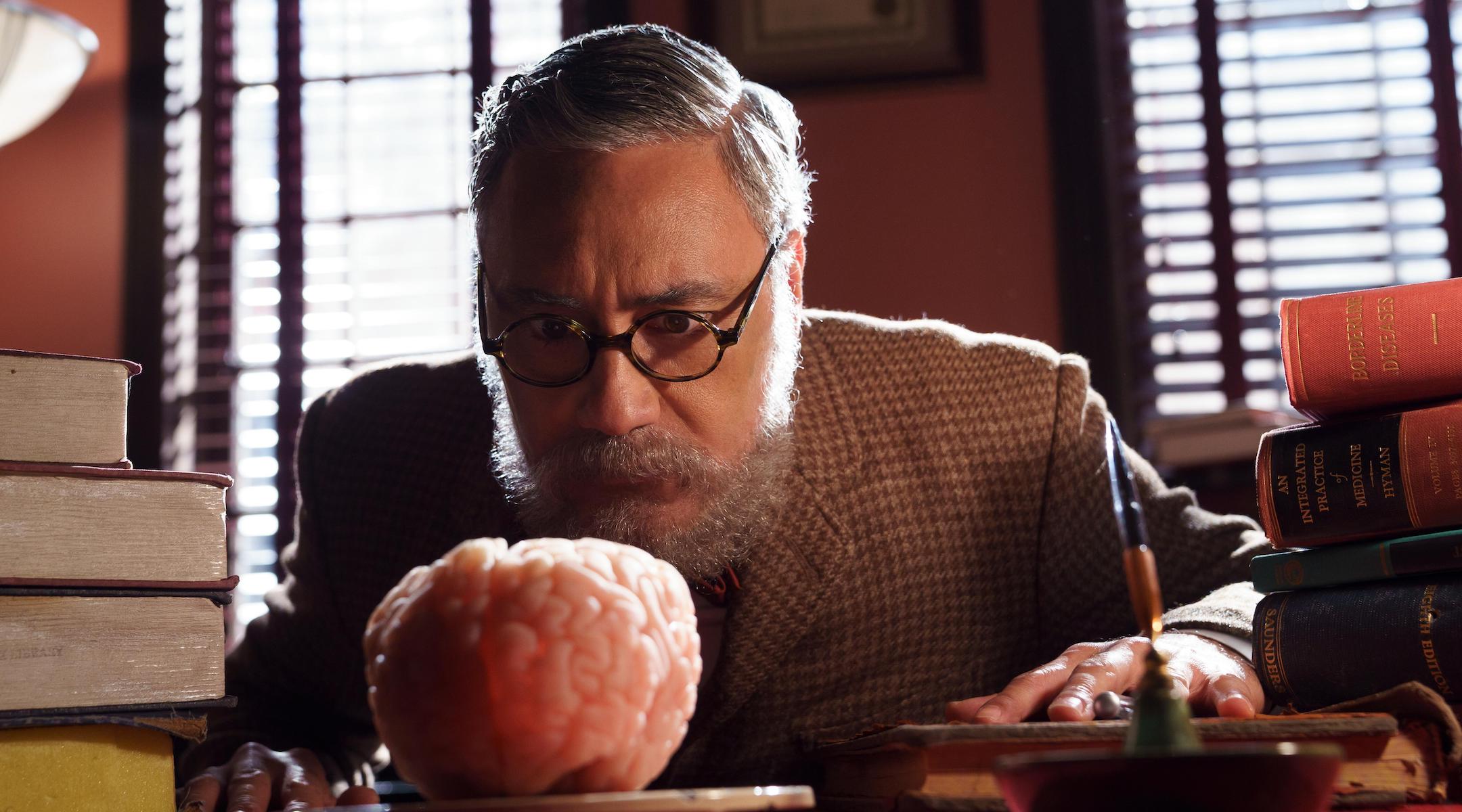
Taika Waititi as Sigmund Freud in “History of the World, Part II.” (Aaron Epstein/Hulu)
Sigmund Freud
A brief sketch shows the Austrian Jewish father of modern psychology conducting a MasterClass — which, in a Freudian slip, he refers to as his “Mommy class.” Played by Jewish Maori actor Taika Waititi, this Freud boasts his lessons will include “my personal archives shared without my patients’ permission.”
As brief as the segment is, it manages to parody quite a bit of the real Freud’s methodology. There are references to his centering of penises in his psychoanalysis, his vocal endorsement of cocaine as a drug with significant medical application, and his theory of the Oedipal complex.
Freud himself often applied his research to Jewish issues, including a dense psychoanalysis of Jewish humor. He left Vienna for England in 1938 after various psychology organizations paid ransom to the Nazis to allow his safe passage and died a year later, mostly having holed up in his apartment in England for fear of being targeted for being a Jew.
Noah’s Ark (and Ham)
Back to the Bible: The story of Noah and the flood gets a Humane Society-friendly twist, thanks to Jewish comic Seth Rogen’s take on Noah. Instead of rounding up two of every animal, Noah’s family is horrified to discover that he has limited his conservation efforts to various breeds of small dog. Noah asks his family if they really want to be stuck on a boat with live tigers for 40 days.
A side note to this sketch is a prominent role for Noah’s son Ham (Barinholtz again). In the Book of Genesis, Ham was present on the ark, but would later humiliate his father after the flood when Ham catches him drunk and naked in his tent. Noah would respond by cursing Ham’s son Canaan, condemning him to live as a slave to his uncles. (In the sketch, Noah’s family turns into cannibals when they vote to devour Ham’s wife, but Genesis describes the entire family as having survived the flood onboard the ark.)
The story of Noah’s Ark has been embraced by Christian fundamentalists in the United States. Some have even tried to verify the events as historically accurate, most notably at “Ark Encounter,” a Christian theme park attraction that opened in Kentucky in 2016 and purports to tell the real history of the Biblical event. Flood myths such as Noah’s Ark are common foundational stories across multiple world cultures and religions.
The Yalta Conference
In this February 1945 meeting in Crimea, held in the final months of World War II, the leaders of the conquering superpowers — Franklin Roosevelt, Winston Churchill and Joseph Stalin — convened to discuss the postwar order in Europe, German reparations and how to repatriate refugees, including the surviving Jewish population. A brief, silly sketch imagines a flamboyant photographer (Andrew Rannells) trying to find an exciting pose for the three men to best capture history.
Records on the Jewish discussion at Yalta weren’t made available to the public until 1955, a decade after the conference, after Roosevelt and Stalin had died. At the conference, Roosevelt had declared himself a Zionist and pushed Stalin as to whether he identified as such, leading Stalin to discuss at great length the Soviet Union’s struggles with “the Jewish problem” (that is, where to put its Jewish population). Unsuccessful efforts were also made to get the Soviet Union to denounce Nazi atrocities against Jews.
Ulysses S. Grant and the Civil War
A long-running “History” sketch involves Union General Ulysses S. Grant’s efforts to secure a drink in the waning days of the Civil War. The bit concludes with a guest appearance from Jewish actor Jason Alexander as a notary public/mohel who must notarize the treaty between the North and the South. During this segment, Alexander drops another Brooks callback, this time from “Spaceballs”: “Why didn’t somebody tell me my ass was this big?”
In these segments, Grant (Barinholtz) is portrayed as a basically decent, if constantly hammered, general. (Historians agree, by the way, that Grant “was probably an alcoholic but a functioning one.”) He even makes a Jewish joke to justify his drinking, saying, “I believe today is what the Hebrews call Pesach.” But in real life, Grant’s tenure as general was marked by a bout of antisemitism. Frustrated with the “mostly” Jewish traders who he felt were gouging the Union, he tried to expel Jews from three states in the midst of the war with his infamous “General Order No. 11,” but revoked the order three days later.
As president, Grant would redeem himself in the eyes of many Jews, first by apologizing for the order, then by appointing Jews to prominent positions in his administration and supporting Jewish-backed efforts to enforce the separation of church and state.
The Civil War segment also contains another brief Jewish joke, when Robert Todd Lincoln (Nick Robinson), trying to stall for time at the gallows, starts thanking “my agents” — and lists off a bunch of stereotypically Jewish names. “We ain’t got time for the Jew stuff,” a Southerner snarls at him.

Quinta Brunson as a groupie of Jesus and the apostles outside “Apples & Honey Records,” in “History of the World, Part II.” (Aaron Epstein/Hulu)
The “Last Supper” Sessions
Yet another take on the life of Jesus finds him and his apostles in a parody of the Beatles documentary “Get Back,” preparing what appears to be his Sermon on the Mount — with Mary Magdalene (Zazie Beetz) in the Yoko Ono role. Jewish references abound, as Judas (Kroll) messes around with a shofar and the group floats the idea of delivering the sermon on Masada in present-day Israel. (Tradition places the sermon at the Mount of Beatitudes in northern Israel.)
The group also records at “Apples & Honey Records,” a play on the Beatles’ Apple Records that also references the traditional Rosh Hashanah meal.
Madeline Kahn
In a parody of Ancestry.com, descendants of Kublai Khan discover their heritage via “Khancestry.com.” The segment also has another Easter egg for Jewish comedy fans, as satisfied customers brag about their relationship with “other famous Khans” — including Jewish comic actress Madeline Kahn.
Brooks fans, of course, know Kahn from “History of the World, Part I,” as well as her Oscar-nominated turn in “Blazing Saddles” and other Brooks collaborations including “Young Frankenstein” and “High Anxiety.” The acclaimed actress, who died in 1999, scored another Oscar nomination for her turn in the Depression-era comedy “Paper Moon,” from director Peter Bogdanovich. Genealogists have yet to determine if she is a descendant of Kublai Khan.

The Oslo Accords as depicted in “History of the World, Part II.” (Aaron Epstein/Hulu)
The Oslo Accords
In the grand scale of the other world events in the series, the Oslo Accords are only recent history. But the tentative Israeli-Palestinian peace framework, brokered in the 1990s, still gets a moment in the spotlight — only to be seemingly derailed when each delegation tries to lay claim to the invention of hummus. Greece, Egypt and Turkey also make plays for credit for the chickpea-and-tahini spread.
The major players of the Oslo Accords (U.S. President Bill Clinton, Israeli Prime Minister Yitzhak Rabin and Palestine Liberation Organization Chairman Yassir Arafat) are nowhere to be seen in the sketch, nor does any of it take place in the White House Rose Garden, where the famous handshake between the parties occurred on Sept. 13, 1993. Instead, a Norwegian diplomat is depicted as mediator, with Jewish actress Michaela Watkins representing the Israeli delegation.
Oslo was notable for establishing certain ground rules required for the Israelis and Palestinians to find a peaceable resolution, including each side recognizing the other’s right to self-determination; the creation of the Palestinian Authority as a governing body; and an agreed-upon Israeli withdrawal from the Gaza Strip and West Bank. The agreement unraveled in the years following the accord, as Israel stalled its withdrawal process, Palestinian terrorism surged (peaking with the Second Intifada) and Rabin was assassinated by an Israeli right-wing extremist.
As for the question of who invented hummus: This bit of culinary archaeology has stumped scholars for centuries. The show touches on real-life controversies over the question: Lebanon has even accused Israel of stealing its claim to the dish during the so-called “Hummus Wars” of the 2000s. Turkey is thought to have domesticated the first chickpea crop, and some historians believe the dish as we understand it may have originated in Damascus, but hummus as a dish is also mentioned in the Hebrew Bible (Ruth 2:14).
For many, the origin of hummus is even more of a quagmire than the Israeli-Palestinian conflict.
The Council of Nicaea
Perhaps the deepest cut of Jewish history across the entire “History” saga is the depiction of the First Council of Nicaea, a gathering of Christian bishops in the year 325 CE. Here, the show’s many different interpretations of the life of Jesus (including its parodies of “Curb Your Enthusiasm” and “Get Back”) are presented to a focus group of ecumenical Church leaders, who are asked to reinvent his story for a “modern” age. One of them wonders why Jesus couldn’t have just used the Israeli martial art of krav maga to fend off his enemies.
The council collectively reaches two major conclusions, which are then presented to the Pope: Jesus should be white, and the Jews should be blamed for his death. A trailer for the rebranded white Jesus, who does battle with stereotypically Jewish “money lenders,” is then aired to roars of approval.
Historians generally hold that the actual events of Nicaea helped lay the framework for the centuries of Church-sponsored antisemitism that followed. In addition to defining the nature of Jesus for what became the Catholic Church, the First Council — convened by the Roman Emperor Constantine I in what is now Iznik, Turkey — crucially changed the celebration of Easter, divorcing the holiday from Passover, even though Jesus’ Last Supper had been a Passover seder. After Nicaea, Christians used their own calendar to determine when Easter would fall. This had the effect of further eroding Christian-Jewish relations.
The charge that Jews killed Jesus predates the Council of Nicaea: As early as the middle of the second century CE, the Church father Justin Martyr was preaching the doctrine. As mentioned before, in 1965 the Catholic Church publication of Nostra Aetate rejected collective Jewish responsibility for the crime.
Future Councils would also mandate that the Christian Sabbath be celebrated on a different day from the Jewish Shabbat, and incorporate increasingly antisemitic language in order to depict Jews as usurpers and betrayers of Christianity.
Jews in Space
Fittingly, the “Part II” opus ends with another callback first teased more than 40 years ago in “Part I,” as well as its own teaser, for “History of the World, Part II: Season II.”
The return of “Jews in Space” resurrects the Star of David spaceship from the first film, but instead of Hasidic Jews piloting the vessel as they dance the hora, we get modern-day liberal Jewish stereotypes played by Kroll, Barinholtz and Sarah Silverman.
Wanda Sykes, one of the show’s executive producers, is here, too — even as the other performers comment on the fact that she isn’t Jewish. That didn’t stop Sykes from getting in on the Brooks callback fun: In an earlier sketch she played U.S. Rep. Shirley Chisolm with a mole that migrated around her face. Asked about the inconsistency, she responds, “What mole?” — a variation of a line first said by the villain Prince John in Brooks’ 1993 film, “Robin Hood: Men In Tights.”
There’s also a space dreidel, lox and an appearance by Brooks himself as… a buff Jesus. It makes more sense if you see it for yourself.
Of course, the idea of Jews in space is not as far-fetched as “History” might have you believe. Since Boris Volynov first soared aboard the Soviet Soyuz 5 spacecraft in 1969, there have been eight other Jewish astronauts.
JTA has documented Jewish history in real-time for over a century. Keep our journalism strong by joining us in supporting independent, award-winning reporting.
